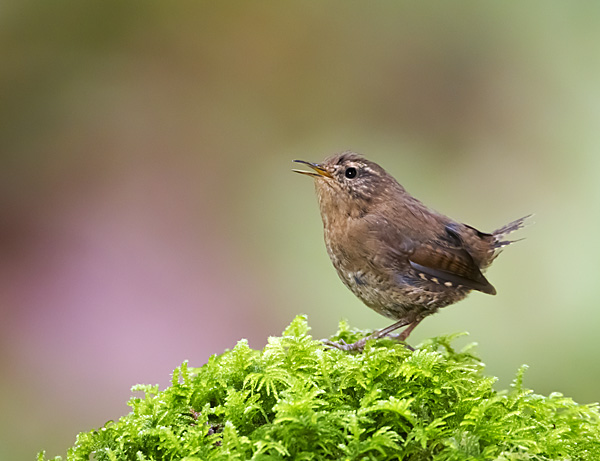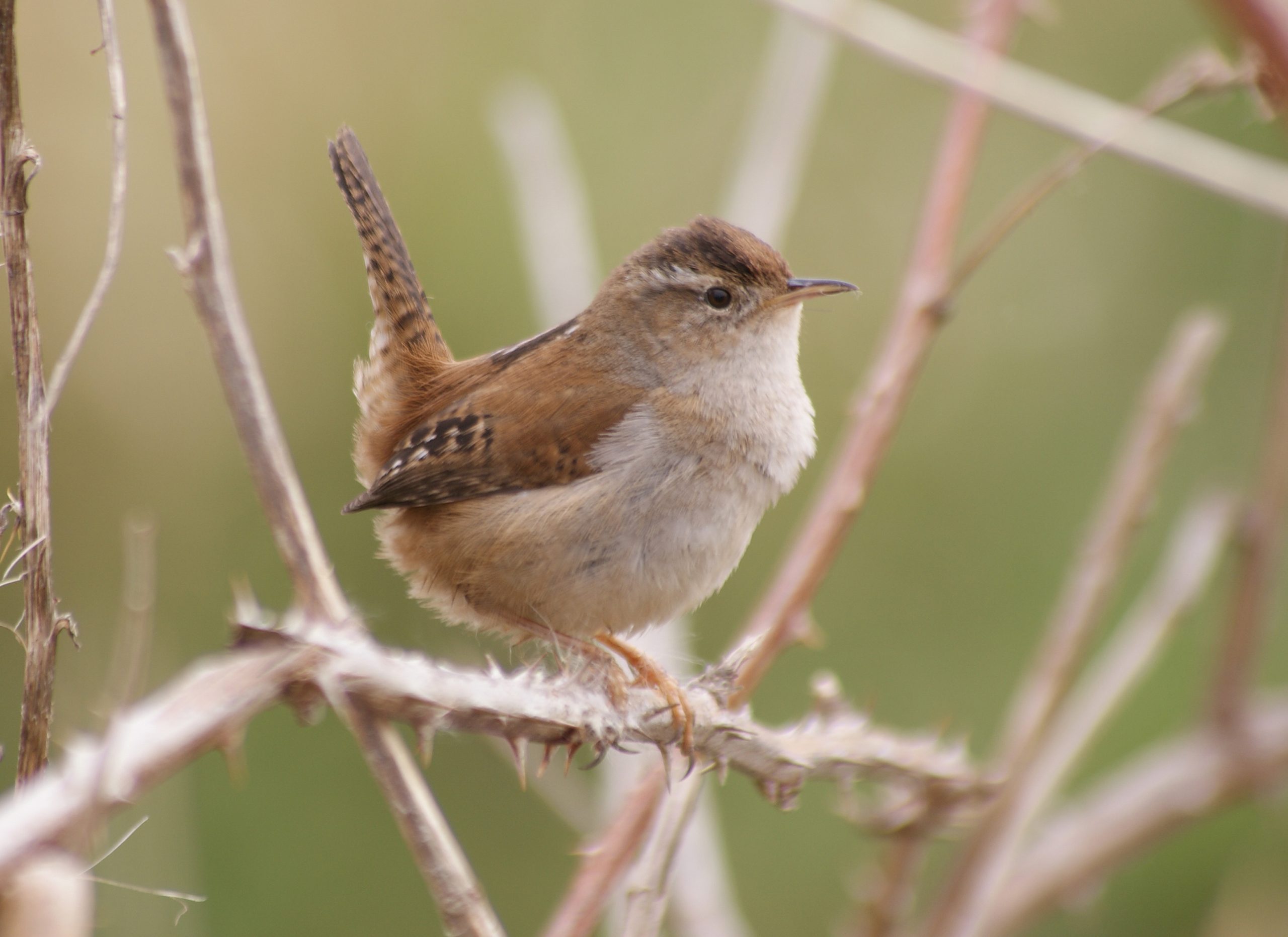Wrens, those charismatic little songsters, may not catch your eye at first glance. They sport a humble brown plumage, small stature, and pleasantly plump physique, all accompanied by their distinctive upright tails and resounding vocal cords.
These avian wonders belong to the Troglodyidae family and are native to the New World, predominantly inhabiting North and South America. However, it’s worth noting that the Eurasian Wren strays from the norm and resides in Europe and Africa.
Across the globe, we can find a total of 88 wren species, with a fortunate three making their homes in Alaska. Among these Alaskan dwellers, the Pacific Wren stands as the regularly observed species, while the other two remain occasional visitors.
The wrens’ diet consists mainly of insects and spiders, affording them the ability to thrive in diverse environments, even those with arid and rocky landscapes where vegetation is scarce.
Initially, it was believed that the Winter Wren shared its species with Pacific and Eurasian wrens. However, recent revelations have distinguished them as separate entities.
Throughout history, wrens have carried deep cultural significance and symbolic meanings. In Europe, there prevailed a superstition that the act of killing a wren would bring about misfortune.
To assist you in identifying the various wren species found in Alaska, we present this comprehensive guide based on avibase. The wrens are listed in order of frequency, derived from birdwatchers’ checklists submitted to ebird for the state.
For a convenient aid in identifying the diverse bird species that grace your backyard, you can acquire a complimentary bird identification photo guide specifically tailored for Alaska.
Let’s now delve into the three wren species that grace the Alaskan landscapes:
1. Pacific Wren

The Pacific Wren holds the distinction of being the most commonly sighted wren species in Alaska. These charming birds grace the coastal regions of the state, appearing in approximately 6% of summer checklists and 4% of winter checklists submitted by avid birdwatchers.
Adorned in shades of brown, their wings, tail, and belly bear darker barring, while a paler eyebrow stripe adds a touch of contrast. These wrens possess short, erect tails and exhibit no visual distinction between males and females.
Key Features: These are the smallest wrens found in the United States.
Scientific Name: Troglodytes pacificus
Length: 3.1-4.7 in (8-12 cm)
Weight: 0.3-0.4 oz (8-12 g)
Wingspan: 4.7-6.3 in (12-16 cm)
Pacific Wrens occupy the West Coast from Alaska down to California. While coastal populations remain throughout the year, those residing inland in Canada migrate south for the winter.
In their natural habitat, you’ll spot Pacific Wrens skulking among the forest floor, expertly concealed within the foliage and decaying logs. Their diet primarily consists of insects, spiders, flies, and bees.
When it comes to serenading the world, Pacific Wrens produce a melodious medley of rapid, high-pitched notes, creating a harmonious jumble of sound.
2. Rock Wren

Rock Wrens, a rarity in Alaskan territory, are regarded as accidental visitors. In fact, their presence was only noted around Gustavus in 2017.
These rock-dwelling marvels sport pale brown plumage adorned with darker flecks. Their wings and tail feature distinct barring, while their underparts exhibit a pale hue with buff coloring on the lower flanks and belly.
Notable Features: With a pale eyebrow stripe, elongated slightly curved bills, and dark legs,
Rock Wrens possess their own unique charm.
Males and females share the same coloring, and when agitated, they engage in a characteristic bobbing motion, making identification slightly easier.
Scientific Name: Salpinctes obsoletus
Length: 4.9-5.9 in (12.5-15 cm)
Weight: 0.5-0.6 oz (15-18 g)
Wingspan: 8.7-9.4 in (22-24 cm)
Rock Wrens can be found in dry, rocky areas across western US states and southwest Canada. While populations in the south and west remain resident throughout the year, those in central US states migrate south for the winter.
To catch sight of these elusive creatures, venture into dry, rocky landscapes that lack abundant vegetation. They scavenge for insects nestled within the crevices of rocks.
When it comes to their vocal repertoire, Rock Wrens boast an extensive catalog of over 100 songs. These songs often consist of repeated patterns, each with its unique pitch.
3. Marsh Wren

Within Alaskan borders, Marsh Wrens make fleeting appearances as accidental species, with the last known sighting occurring around Ketchikan in 2019.
Sporting a brown plumage adorned with black and white streaks on their backs, these wrens exhibit a grayish-brown underside, coupled with the characteristic upright tail seen in their kin.
Distinguished by their lack of shoulder stripes and longer bills in comparison to Sedge Wrens, males and females share identical appearances.
Scientific Name: Cistothorus palustris
Length: 3.9-5.5 in (10-14 cm)
Weight: 0.3-0.5 oz (9-14 g)
Wingspan: 5.9 in (15 cm)
During breeding season, Marsh Wrens occupy the northern states of the US and central regions of Canada before migrating to southern states and Mexico. Some individuals in the west and along the Atlantic Coast opt to remain resident throughout the year. These wrens can be spotted during their migration period in the eastern US.
Marsh Wrens thrive amidst wetlands, clinging tightly to reeds as their feet adroitly grasp separate stalks. Spotting them may prove challenging, but their melodious songs emanating from the reeds, especially at dawn and dusk, act as telltale signs.
Their diet primarily consists of insects and spiders, which they diligently procure from leaves near bodies of water.
When it comes to vocal performances, Marsh Wrens impress with their distinct buzzy songs, which can extend up to 20 minutes.
In constructing their nests, Marsh Wrens exhibit a meticulous nature. These nests are fully enclosed, except for a small opening at the top, and are carefully woven from reeds and grass. Marsh Wrens lay 3 to 10 eggs, with hatching taking around two weeks, followed by an additional two weeks for fledging.
Fascinatingly, Marsh Wrens may construct up to twenty dummy nests, cleverly attached to cattails, although they generally utilize only one nest and go as far as destroying the eggs and nestlings of rival birds.
How to Attract Wrens to Your Backyard
Now, if you’re yearning to attract wrens to your own backyard, here are some tried-and-true methods:
1. Embrace a little messiness: Provide habitats for insects and spiders, the wrens’ preferred delicacies. By leaving fallen leaves, brush piles, and spider webs, you create an inviting environment.
2. Offer clean water sources: Multiple locations with running water would be ideal.
3. Create nesting sites: Wrens happily occupy nest boxes, and they might even make use of your old boots if left out!
4. Offer delect able treats: Wrens readily consume mealworms, crickets, peanuts, and suet.
How Frequently Wrens are Spotted in Summer and Winter
For those curious about the frequency of wren sightings during summer and winter, the following data based on ebird checklists offers insight:
Wrens in Summer:
– Pacific Wren: 6.5%
– Rock Wren: <0.1%
Wrens in Winter:
– Pacific Wren: 4.2%
– Marsh Wren: <0.1%
